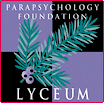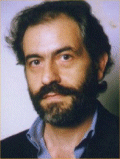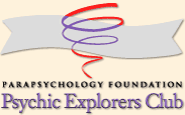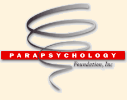 |
 |
| Massimo Biondi, M.D.  In no one period of my life did I decide to become a parapsychologist. This profession doesn’t exist in my country (Italy), so to think about practising parapsychology is just nonsense. However I have chosen many times to remain interested and engaged in parapsychology: after periods when my regular job or simply fatigue brought me far away from the field. In no one period of my life did I decide to become a parapsychologist. This profession doesn’t exist in my country (Italy), so to think about practising parapsychology is just nonsense. However I have chosen many times to remain interested and engaged in parapsychology: after periods when my regular job or simply fatigue brought me far away from the field.
The first time I addressed this discipline with the will to actively do something (I hope something useful) was in the 1970s, when I met a few other Italians interested in parapsychology. But the lack of regular parapsychological courses and schools prompted me to become self-taught, to educate myself. Then I read and studied a lot of the classical works in the field, such as — among many others — Rhine’s, Sudre’s, and Wolman’s books. During that period, Italy was a place with a deep popular interest in parapsychology and the “occult”, so many books were published and a consistent debate ensued surrounding the interesting topics of this area. For example, people discussed: the problems posed by Trevor Hall’s books; what could properly be considered “mediumship”; whether Rhine’s experiments had proved telepathy and psychokinesis. In terms of periodical publications, however, all what existed then in Italy were popular journals and magazines, so after a little time I began to subscribe to international journals: the Journal of Parapsychology, the European Journal of Parapsychology and so on. I began to conduct research along the lines of Rhine’s procedures with Zener cards and dice. With the aid of some friends, I performed many thousands of runs, but the majority of this I did alone. I tried to obtain “significant” results, sometimes by giving myself “prizes” (for example, by writing on the back side of some cards what wonderful thing I’d allow myself to do or have if I detected the identity of the card correctly). I also studied the effects of fatigue on my performance: every night, for about five months, I tried to clairvoyantly “see” 500 cards (from packs prepared weeks before), writing entries about my moods. In all of these experiments I obtained no results that differed from the mean chance expectation, but I learned lessons about how to perform an experiment, how to evaluate the results, and how to read the papers published in specialized journals. About the majority of this work, I published nothing, because that was the way Italians (maybe not only Italian) parapsychologists were at the time: only research that produced significant results was thought to be important to communicate. Years later this opinion was proved completely wrong, not only because every inquiry has to be published so as to obtain a correct understanding of the overall experimental results of a field, but more importantly because all data is useful data, when one works to extend and expand hypotheses and theories. After 1986 my interests concentrated mostly on “spontaneous cases.” Here I performed some original inquiries, with interesting results. In my investigations of poltergeist cases, for example, I realized that the “phenomena” have to be studied not only for themselves (e.g., the objects involved, trajectories of movements, distances between objects and agents, and so on), but also from a psychological point of view, because in many cases the disturbances have a role, a function for the agents. Such agents seem to “use” the phenomena and their recurrences so as to obtain something: to be given something, to be exonerated, to be sent elsewhere, to meet someone, and so on. Similar to these cases, I also examined some haunting-like cases. In particular, in one of these, multiple apparitional experiences, many feelings of presence as well as a few other phenomena occurred, some of which emerged during my own inquiry (and continued for almost thirteen years). The case began as one that centered on the appearance of a ghost, but because I became familiar with the inhabitants of the house where the case occurred, I had the good luck to be around for as new features of the case emerged. Always in the area of spontaneous cases, I collected many instances of what are known as “telepathic impressions” as well as a lot of near-death experiences (which I no more consider to be parapsychological in nature). After a case that my father experienced, I began a national inquiry on so-called “phone-calls from the dead.” In newspaper articles and interviews, I didn’t recount too many details of what Rogo and Bayless had found in their research on this subject. By keeping the definition fairly open, I was able to collect about seventy stories, out of which 16 enigmatic cases were selected: a few apparently from dead people but more between two living people not really talking to one another. I'm still continuing to collect new cases of these types. For about twenty years, another line of my activities in this field has been to give lectures. This I think is very useful, because in this way one learns to study and to organize information, to amplify his or her own knowledge, and to reflect deeply on phenomena, methods and theories. Over the years, this activity has evolved from popular courses and conferences, to addresses in congresses and seminars, and to teaching aids that I have been requested to prepare for undergraduate students who are moving on to their master theses. My last line of interest in parapsychology has been my love for historical topics. My affinity for the history of parapsychology began in 1982, when, while summarizing the birth of the S.P.R. in a paper, I found that very few Italian authors knew about that event and other important past events. Stimulated by Trevor Hall’s books, I continued to try to understand and disseminate some basic issues, such as: Who were the figures who founded the S.P.R.? What was the truth surrounding the death of the suicide of Edmund Gurney? What were the links between Freud and his first followers and occult topics? Who were the important Italian men and women who worked in parapsychology, were mediums or active in spiritism (this was one of my main historical interests in the past, but I have moved on to other topics more recently), including those obscure and disgraceful “parapsychologists” who contributed to the racial laws and politics of Fascism. Although my historical works are simply “armchair” studies, it is difficult to pursue them when one is alone (in Italy the few interested people are geographically dispersed), and they require much dedication and a lot of money and time. These days, thanks are due to Internet for the ease with which a researcher can now find documents and publications, and for the way in which the Internet has contributed to all fields of research in parapsychology, inspiring new work. My engagement in parapsychology has not so far and cannot ever become a professional job. Like a lot of other people, I search for ways to contribute to this slowly growing area: but certainly I suffer from my living at the borders of the Empire (that being the English-speaking region). The persistant lack of an “Italian journal of parapsychology” is a heavy obstacle to increasing activity in every direction that I — and a few other people in my Country — would love to perform. It is difficult to write and communicate in English and to make progress in the face of such obstacles. All of this, however, should not to be considered a complaint; it’s only an explanation of the difficulties one has to overcome to do “honestly” some parapsychology. From my experience, on the other hand, I can say that some obstacles are better than none: because obstacles can act as a stimulus to those who are really interested in the field, and as a kind of natural selection that excludes those who are not well-grounded or competent. Because the parapsychology offers a unique chance to study intriguing facets of the deepest regions of the human psyche and of behavior, I feel that in the future I will continue to try to contribute to this discipline, no matter what obstacles or barriers I find as I walk this path. Alvarado, C. S., Biondi, M., & Kramer, W. (2006). Historical notes on psychic phenomena in specialised journals. European Journal of Parapsychology, 21, 58–87. Biondi, M., (1995) Psicoanalisi e parapsicologia. Luce e Ombra, 95, 27–36. (Click here.) Biondi, M. (2000) Parapsicologia: qualche bilancio da un profilo storico. Scienza & Paranormale, 8 (n. 30), 24–33. (Click here.) Biondi, M., (1982) Cronaca e storia della costituzione della S.P.R. Luce e Ombra, 82, 289–301. Biondi, M., (1983) Giovanni Battista Ermacora e la ricerca psichica. Luce e Ombra, 83, 177–188. Biondi, M., (1988) Tavoli e medium. Storia dello spiritismo in Italia. Gremese, Roma. Biondi, M., (1989) Investigating the paranormal. Metapsichica, 42(1), 52–70. Biondi, M., (1991) Cinque casi di impressioni telepatiche. Metapsichica, 46(1), 73–82. Biondi, M., (1994) Tentativi di ricerca psichica in Italia tra Ottocento e Novecento. Quaderni di Parapsicologia, 25(2), 11–26. Biondi, M., (1997) Esperienze tipo-poltergeist e modelli di interpretazione. Quaderni di parapsicologia, 28 (2), 36–48. Biondi, M. (1997) Analisi fenomenologica delle NDE. Atti del Primo congresso internazionale di studi delle esperienze di confine, San Marino, May 16–18, 1997: 71–86. Biondi, M. (2000) La piccola parapsicologia. Quaderni di Parapsicologia, 31(1), 20–33. Biondi, M. (2002) Il ganzfeld? La metanalisi? Forse, ma… Quaderni di Parapsicologia, 32(1), 23–29. Biondi, M., (2004) La Ricerca Psichica. Il Minotauro, Roma. Biondi, M. (2004) Le esperienze apparizionali dei bambini: Analisi di una casistica. Quaderni di Parapsicologia, 35(2), 82–94. Biondi, M., (2005) Misteriose presenze. Mondadori, Milano. Ravaldini, S., Biondi, M., & Stevenson, I., (1989–90) The case of Giuseppe Riccardi: An unusual drop-in communicator in Italy. Journal of the Society for Psychical Research, 56, 257–265. ******** Prepared for the “Lives in Parapsychology” Blog first posted on June 26th, 2006. |
 |

|
 www. parapsychology. org |
||